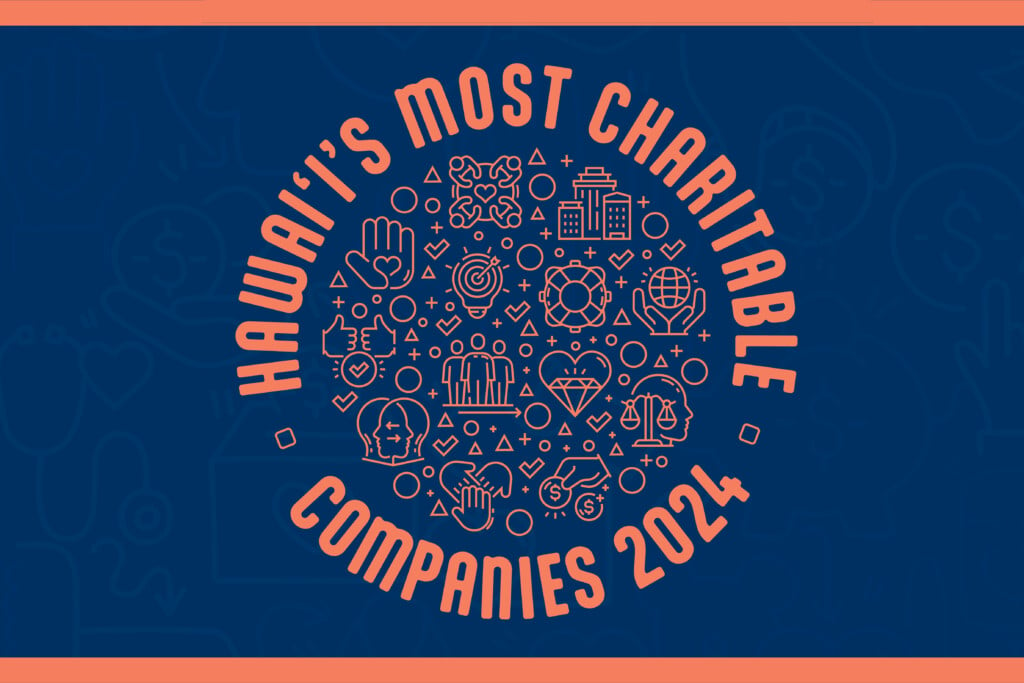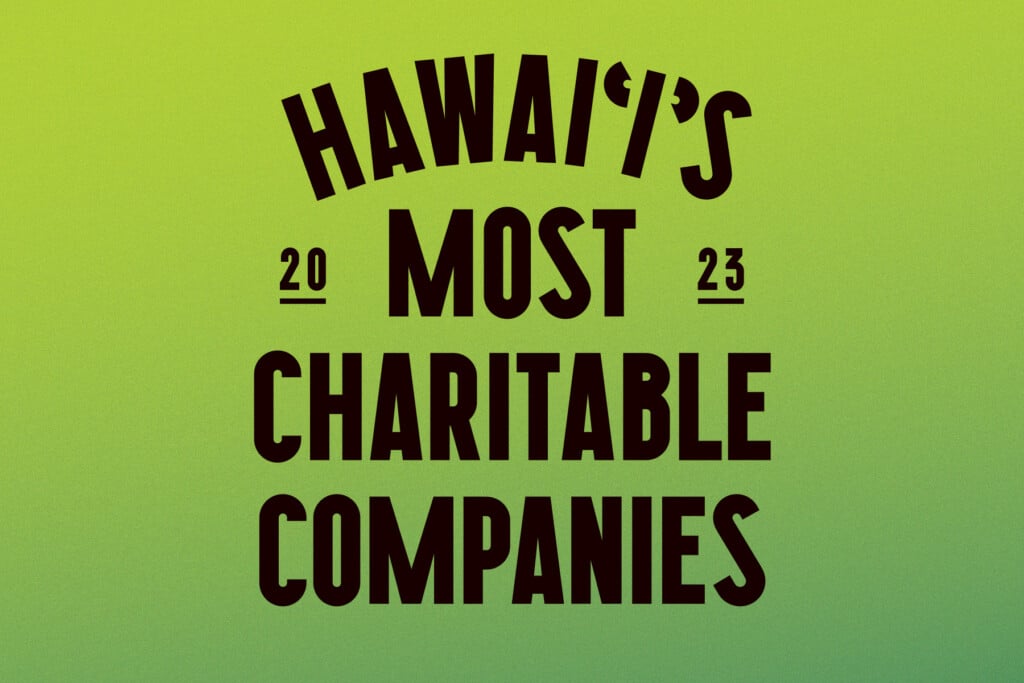Hawaiʻi’s Most Charitable Companies 2016
We are proud of the traction Hawaiʻi's Most Charitable Companies has gained since the inaugural list in 2012, which included 53 companies.

This year’s edition is our biggest yet, with 126 organizations giving $118 million total in cash and in-kind gifts during 2015.
Hawaii Business’ mission is to, “Strengthen the local economy and help our communities thrive,” so we are delighted to highlight and celebrate philanthropy by companies, nonprofits and individuals. We hope the list serves as an inspiration to others who want to make a difference in the Aloha State.
Giving has increased as the economy strengthens, but donors have become more discerning. “They want to see more concrete results,” says Norm Baker, COO of Aloha United Way.
“Telling investors, ‘We gave X amount of dollars,’ is not very helpful,” he says. “What nonprofits need to do is provide reports that give measureable outcomes tied to an organization’s mission. Investors don’t want to hear we helped 100 people. What they want to hear is: ‘We help the homeless and, thanks to your contributions, we were able to place 20 families in stable homes on Oahu, where they have remained for at least six months’.”
Reporting this kind of data often requires technology, which makes it difficult for smaller nonprofits that can’t afford the investment. This presents a conundrum for many entities, particularly because overhead rates – how much it takes to operate an organization – are constantly under a magnifying glass.
“For better or for worse, one of the key metrics of success are overhead rates,” Baker says. “Some see it as an indicator of efficiency.” Aloha United Way’s rate is 16.4, which means that, for every dollar it receives, 83.6 cents directly helps the community.
“It is a delicate balancing act,” he says. “We want to adopt cutting-edge technology, boost infrastructure and invest in our people, but we also have to keep those rates as low as possible because smart investors will take a look at them.”
REALITY CHECK
Local fundraisers concur that giving is dramatically up since the gloom-and-doom days of the Great Recession. Hawaii’s Giving Study, which the Hawaii Community Foundation published last year, found that individuals gave some $600 million in 2014. On average, local households gave $2,024 – a rise of 35 percent since 2008. Anecdotally, corporate giving has also risen.
While the landscape has improved, not everybody is chanting victory. “It is still not time to pack up and say: ‘Yay, everything has gotten better,’ ” says Kelvin Taketa, longtime president and CEO of the foundation.
Sure, there has been linear growth since 2008. But when you expand that scope and examine the last 15 years, you find that overall giving is actually flat. “Since 2000, growth has been zero when you adjust for inflation,” Taketa explains. “We have been treading water.”
CONNECTING THE DOTS
Giving is largely a reflection of investment growth and wage growth, which provides important insight into why overall giving is flat. On the investment side, corporations have seen steady growth, Taketa says. But this hasn’t materialized into hefty gains because, while corporate philanthropy is vital in Hawaii, it represents a small piece of the overall pie.
This could be a function of our market size. “Relative to the Mainland, there is not a large corporate base in Hawaii. “When you compare it to a Columbus or to a Raleigh-Durham, Honolulu is small.”
Another dynamic could be that many of our large companies, including some of our big hotels, are headquartered outside of the state, which makes vying for philanthropic dollars more of a challenge.
The picture gets more complex when it comes to individual philanthropy.
The good news is that national unemployment has been slashed by about half from a peak of 10 percent in 2009, with Hawaii boasting a rate of 3.4 percent this August, according to the Department of Labor and Industrial Relations.
The problem is that salaries have been notoriously stagnant during this period, except for last year, when real median household income grew by 5.2 percent to $56,500, according to a recent report from the Census Bureau. More money in wallets could translate into a more potent boon – one that produces real growth.
CUTTING TO THE CHASE
One of the most important metrics HB’s Most Charitable Companies list captures is the ratio of how much organizations give in cash and in-kind gifts relative to their gross sales. This year’s average is 0.30 percent. Keep in mind two important factors that we implemented to derive this figure:
1. We excluded four philanthropic powerhouses from the list, including the Hawaii Community Foundation, which gave $45 million or 93.5 percent of its revenue; Aloha United Way, whose $13.4 million in donations constituted 93 percent of its revenue; Parker Foundation, which donated 22.3 percent of its $2.2 million in revenue; and Kamehameha Schools, which donated $23.6 million, or 9.8 percent of revenue. HB adopted this measure so that the average wouldn’t skew high.
2. We excluded the companies that did not provide their total revenue for 2015 because the rate could not be calculated.
Among for-profit companies, Stars Above Hawaii took the lead again, giving almost 6 percent of its revenue to charity. The company, which provides astral shows using powerful telescopes, has a strong track record of generosity – it also held the highest ratio of giving to gross sales in 2015 and 2014.
Rounding out the top three for-profits with the highest ratio of giving as a percentage of gross sales were Group 70 International, which donated 1.35 percent of revenues, and Architects Hawaii, which gave 1.34 percent.
Volunteer hours is also another important metric we evaluate. The list looks at volunteer hours employees contribute both during paid company time as well as pau hana. The average number of volunteer hours during the 9-to-5 workday is 1,404. The average number of volunteer hours donated pau hana is 1,985. Note both of these averages exclude organizations that did not provide the relevant data.
COLLECTING THE DATA
Each year we gather information on how local companies, employees and nonprofits are giving to our community. This includes a wide spectrum of donation methods, such as cash, in-kind gifts and volunteer hours.
It’s not a straightforward process. For instance, many companies do not keep precise records of donations. So when you see a blank entry on the chart, starting on page 58, it does not necessarily mean there wasn’t a contribution. Chances are the data point was simply not tracked.
Another hurdle we face when compiling the list is that many companies – often because they are humble and don’t want to draw attention to themselves – decline to participate in the survey. Consequently, this list is not as comprehensive as we would like it to be.
Finally, we acknowledge that the list features both private companies as well as nonprofits under one umbrella, which some say is like comparing apples and oranges: One group exists for the purpose of giving while the other is in business to generate a profit. We are cognizant that the playing field is not level.
Despite its limits, the feedback HB has received from the fundraising community is that Hawaii’s Most Charitable Companies list is an important barometer of philanthropic giving in the state. It also serves as an incentive to local entities who want to give, but don’t have a benchmark of where to start.







